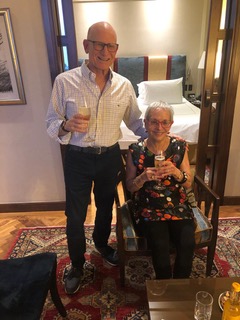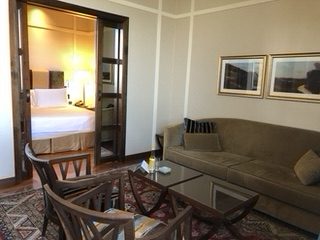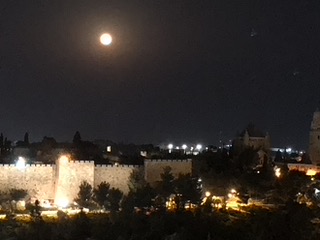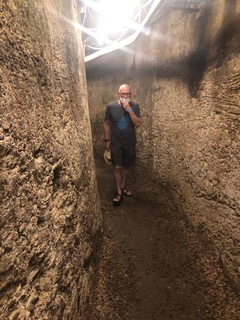 JERUSALEM — Like many of you, Michal and I haven’t visited anywhere overnight since March. Regardless, we didn’t want to celebrate our significant wedding anniversary at home in our apartment. Besides that, the anniversary occurs this year on the eve of Yom Kippur; obviously, no celebration then.
JERUSALEM — Like many of you, Michal and I haven’t visited anywhere overnight since March. Regardless, we didn’t want to celebrate our significant wedding anniversary at home in our apartment. Besides that, the anniversary occurs this year on the eve of Yom Kippur; obviously, no celebration then.
After considering a vacation at various locales in Israel’s Galilee or Golan regions during the early part of September, we followed the example of another anniversary couple and booked two nights in Jerusalem, where we always have a good time.

Since it’s our Ruby Anniversary, we decided to treat ourselves to a deluxe hotel, of which there are five in Jerusalem which come to mind: King David, Inbal, David’s Citadel, Mamilla, and Waldorf Astoria. Like many tourism cities which are suffering from a lack of tourists, the prices have been reduced across the board in Jerusalem. All the deluxe hotels are clustered near the Mamilla Mall, a convenient walkway to the Jaffa Gate entrance to the Old City.
We chose the King David Hotel, which is the most historic, founded in 1931 by an Egyptian Jewish banker, with a storied Zionist history and fabulous Art Deco-Middle Eastern-Eclectic interior design. We were joined by another celebratory couple, as well as two other couples, each opting for a one-night stay. Because of the pandemic, venues were uncrowded and everyone wore masks.

From the hotel website, we chose a larger room facing the pool area and the Old City. We were upgraded to a lovely mini-suite just below the top floor. It had a great view, with a separate bedroom and a lounge area for entertaining, which we took advantage of on both evenings of our stay. The staff at the hotel was very attentive and helpful, although there is no doubt that without the coronavirus reduction in the number of employees, it would have been even better.
We arrived at the hotel at noon, left our car and luggage, and picked up our free voucher for a special exhibit at the recently re-opened Tower of David Museum. It’s just inside the Jaffa Gate entrance to the Old City, where we were struck by the stark, empty streets which ordinarily would have been filled with tourists and vendors. Our destination was the exhibit, “Banai: A Musical Journey From Persia to Jerusalem.” The display portrays the journey of the Banai family, 19th century immigrants from Iran, through more than a century of tradition, history, and development. The family is famous because of its three generations of singers, musicians, and actors.
The Banai family name means ‘builder,’ and the exhibit portrays how the family built the heart of Israeli culture. The Banai clan is a very talented multi-generational family, synonymous with culture here. We spent about 90 minutes watching, listening, and reading about the family’s impact, enjoying many video clips of various Banai family members, as well as much general information on Iranian Jewish culture and Jerusalem’s sociological canvas.
Afterwards, we strolled back to the hotel through the Mamilla promenade, keeping our distance, and stopped for a light lunch at the Roladin Cafe, an excellent coffee/bakery chain throughout Israel.
Instead of dinner that evening, we opted for the late afternoon English Tea that the King David features. We were served on the expansive porch with its panoramic view of the Old City, the hotel pool, and gardens. On many occasions, Michal and I have had lunch or coffee and cake at this stellar location. In this instance, I have to admit that the Tea was disappointing and not at all what we expected. Instead, I would recommend ordering from the lunch menu, which has an excellent choice of light meals and desserts at a reasonable price.

After the Tea, we opted to skip dinner. The concierge had helpfully sent six wine glasses, a bucket of ice, and additional chairs to our room, so we enjoyed snacks and a sparkling wine with friends in lieu of dinner. The view of the sunset over the Old City, stretching as far as the edges of the Judaean Desert, was spectacular, as was that of the Old City at night.
Israeli hotel breakfasts are well known for their expansive buffet spreads, but in the current circumstances the King David has opted for waiter service instead of a buffet. We were seated in the dairy restaurant at a large table. The menu was extensive and, of course, one could have as many choices as wanted. Afterwards, we headed to the pool area located on lovely grounds below the hotel. While not an immense, uniquely shaped pool with bridges and waterfalls, the pool area still manages to be fabulous. There were chairs and umbrellas galore, a nice sized pool with a terrific seating area, and an outdoor snack bar. We stayed for several delightful hours until mid-afternoon, when we returned to our spacious accommodations.
The one mistake we made was to book a tour during a heat wave at the City of David National Park, adjacent to the Old City Walls. Not that I don’t recommend visiting there, but we’ve been several times and have noticed that all the tours, and there are several, begin with the same panoramic view and lengthy lecture. Coupling that with the 105 degree heat (verified on my iPhone), we could have done without it. However, since we were taking the “From the City of David to the Western Wall” 90-minute tour, it was interesting to see what had changed since our last visit.

We expected to begin our tunnel walk up to the Western Wall next to the giant “mikva” (ritual bath). There, pilgrims during the Second Temple period immersed themselves before climbing up through to the Temple Mount. (The ascent is currently through an underground drainage tunnel.) This visit, the tour skipped the mikveh area and was taken to the former parking lot opposite the park’s front gate, an archaeological area that contains a majestic Roman villa, which might have been owned by a Roman official or an assimilated and wealthy Jewish family. This meant that our time in the tunnel was only a quarter hour instead of at least twice as long. Nevertheless we enjoyed the cooler below-ground temperature during the “hike.” Be forewarned – even average-sized people must often duck under the narrow pathway’ low ceiling.
In any event, the highlight of the tour is at the end, when exiting the tunnel one faces the monumental foundation stones of the Western Wall at the foot of the Temple Mount. It’s not hard to imagine the elevated feeling that thousands of pilgrims had when taking this – then above ground – route during the three pilgrimage holidays to Jerusalem: Sukkot, Pesach, and Shavuot.
We returned to the hotel by taxi and rested before entertaining six friends in our room, including one couple who drove in from Ra’anana to help us celebrate. The evening’s restaurant choice was “1868,” which features some of the best gourmet Kosher meat dining in Jerusalem. It’s located in an old stone structure a hundred meters from the hotel. The food is made to the highest standards with every little detail in place. As one would expect in a chef restaurant, the service is excellent. We had a relatively quiet location, despite being near the walkway to the very busy garden and bar. The crowd was mostly a generation younger than our group of eight. Everyone loved the bread and appetizers, as well as their choice of entree and dessert. Highly recommended for a meal that’s special.
The next morning, after another sumptuous breakfast, this time in the main dining room, we enjoyed another few delightful hours at the pool, despite the heat, before reluctantly ending our mini-vacation. We did indeed feel that Jerusalem and the King David had provided a stay like being “overseas.” The fact that Jerusalem is our nearby capital of Israel made it all the better.
*
Steve Kramer is a freelance writer based in Kfar Saba, Israel.